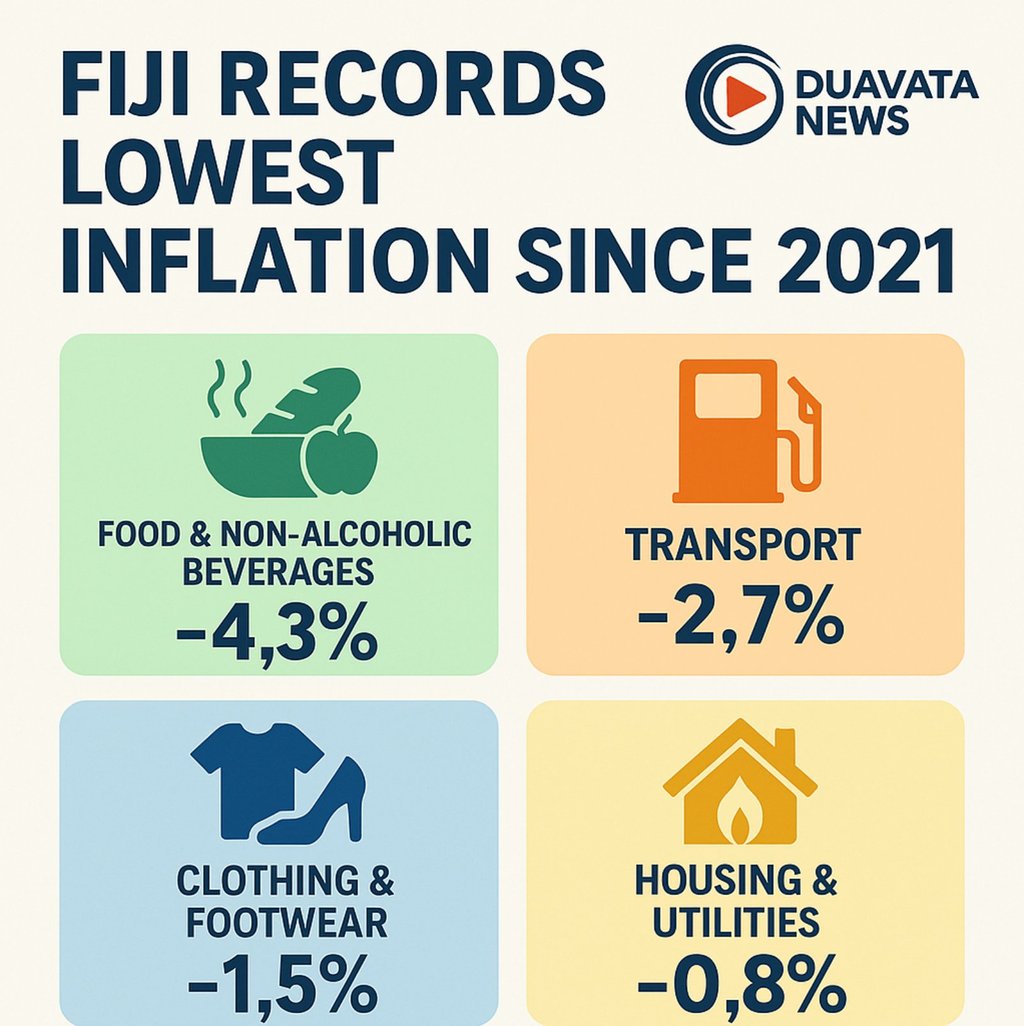Fiji Records Lowest Inflation Since 2021 Amid Sharp Drop in Food and Fuel Prices
FIJI NEWS


Fiji's annual inflation rate plunged to -0.9% in April 2025, marking the first negative year-on-year inflation figure in nearly four years, according to the latest Consumer Price Index (CPI) report released by the Fiji Bureau of Statistics.
The dramatic reversal from 7.1% inflation in April 2024 and 1.5% in March 2025 is the lowest monthly inflation recorded since May 2021, when inflation dipped to -1.6%. Month-on-month, the CPI fell by 0.6% between March and April 2025.
What’s Driving the Drop?
The sharp decline was largely driven by price reductions across several key sectors:
Food and Non-Alcoholic Beverages: -4.3%
A major contributor to the deflation trend, with lower prices recorded for essential items such as bread, cereals, meat, fish, oils, and fruit.
Transport: -2.7%
Motor vehicles, spare parts, and fuel prices all dropped—offering relief for consumers burdened by high commuting costs in recent years.
Clothing and Footwear: -1.5%
Apparel and footwear saw reduced prices across both imported and locally sold goods.
Housing and Utilities: -0.8%
Modest declines in energy-related costs, particularly cooking gas, also played a role in reducing overall CPI.
Furnishings and Household Equipment: +0.4%
Although this category rose slightly, the increase was marginal compared to the major declines elsewhere.
But Not All Prices Are Falling
Despite the overall decline, certain categories posted notable increases:
Miscellaneous Goods and Services: +9.6%
This includes items such as personal care products and jewellery, which saw strong price surges.
Alcohol, Tobacco and Narcotics: +3.9%
Beer and yaqona prices fell slightly month-on-month, but year-on-year, the category still registered a strong upward trend.
Health: +1.4%
Ongoing increases in the price of medical goods and services contributed to this rise.
Restaurants and Hotels: +2.3%
The service sector continues to see price pressure amid recovery-driven demand and rising operational costs.
While the 12-month average inflation (from May 2024 to April 2025) still stands at a moderate +3.3%, this latest April figure suggests a new deflationary trend may be emerging—raising questions about consumer demand and broader economic momentum.
The data is collected from major urban centres including Suva, Lami, Nasinu, Nausori, Lautoka, Nadi, Ba, and Labasa, but is taken to be representative of nationwide household consumption patterns.
Implications for Fijian Households
For everyday Fijians, falling prices—particularly in food and fuel—provide some relief amid ongoing concerns about the cost of living.
Fiji’s inflation is heavily influenced by external factors like global fuel prices, which directly impact transport and energy costs. Currency fluctuations and rising import costs—especially from major partners like Australia, New Zealand, and China—also drive domestic prices. In addition, global supply chain disruptions and natural disasters in the region can quickly push up the cost of essential goods.
The next CPI update will be released on 29 May 2025, which will offer further insight into whether April’s deflation was an anomaly or the beginning of a longer trend.
For now, consumers are cautiously welcoming the relief—especially at the supermarket and petrol pump.
Source: Fiji Bureau of Statistics (FBoS), Release No. 27/2025, 2 May 2025.